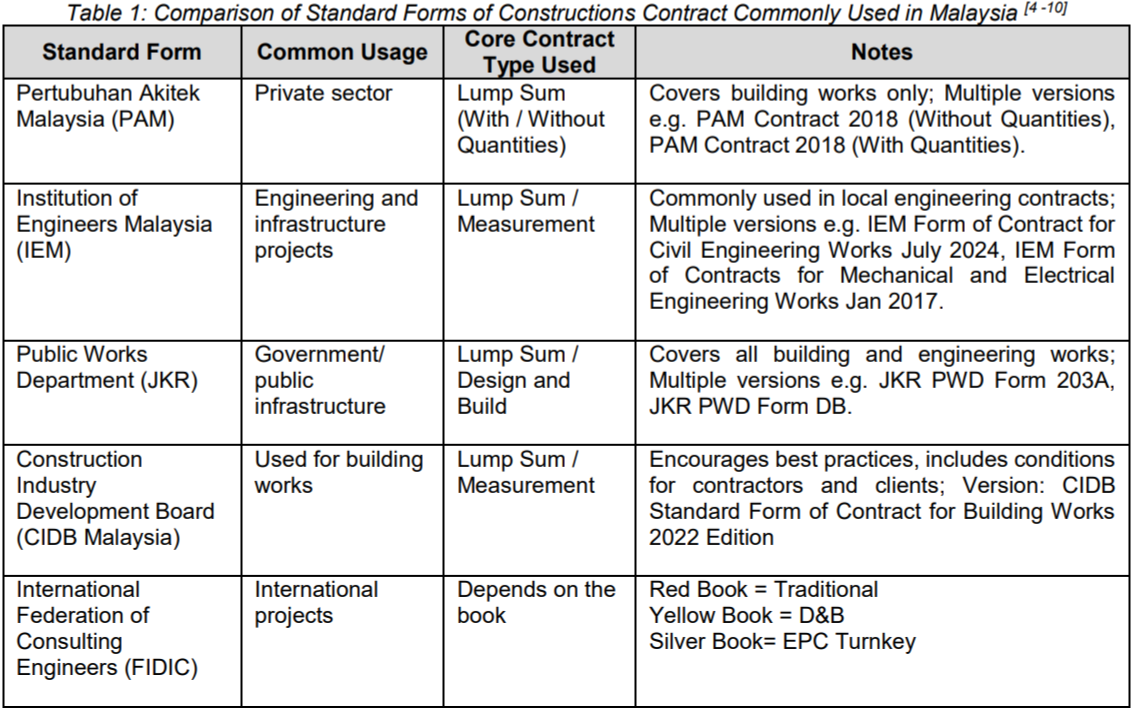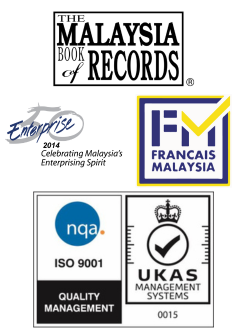Author: Ir. Dr. Justin LAI Woon Fatt | 29 June, 2025
Construction contracts play a vital role in establishing clear objectives and responsibilities while safeguarding the interests of both the client and the contractor involved in a construction project, regardless of its scale. Although there are various contract types available, most are derived from a few core structures. Depending on the nature and requirements of the project, an appropriate contract type must be selected carefully. Once agreed upon, the contract serves as a binding document between both parties, helping to minimize conflicts, and ensuring a smooth project execution. Therefore, selecting the right type of contract before commencing any construction work is essential to avoid unnecessary disputes in the future.
CORE TYPE OF CONSTRUCTION CONTRACT
The following are several core types of construction contracts that are commonly used and practiced in Malaysia;
- Lump Sum Contract (Fixed Price)
A lump sum contract, also known as a fixed price contract, involves an agreement where the contractor completes the project for a set price. This type of contract is most suitable when the project scope is well-defined [1]. It enables the client to transfer risk to the contractor, as the price remains unchanged despite potential fluctuations or changes during execution. In anticipation of unforeseen issues, contractors often include contingency sums to cover unexpected costs. - Measurement Contract (Unit Price)
Also referred to as a unit price contract, this agreement allows the owner to pay for work based on agreed unit rates for materials or services. It is often used when the full scope is uncertain but measurable items like quantities can be estimated. This contract type is commonly discussed and finalized during the bidding stage. Adjustments can be made if the scope change, and it offers the advantage of tracking actual quantities used, particularly effective when a Bill of Quantities (BQ) is prepared or detailed quantity take-offs have been completed [2]. - Cost Reimbursement / Cost-Plus Contract
In a cost reimbursement or cost-plus contract, the contractor is reimbursed for actual costs incurred during the construction process, in addition to a fee covering overhead and profit. This approach is typically used when the project scope is not yet fully defined [1]. While it offers flexibility and allows scope adjustments, it places a higher financial risk on the client due to potential cost escalations and the need for close cost monitoring. - Design and Build Contract
Design and build contracts combine design and construction under one agreement with the contractor, making the project process more efficient compared to the traditional design-bid-build model. The client is typically involved during the design phase and may influence key decisions. This method promotes coordination and faster completion. The contractor’s role often ends after construction, with handover, testing, and commissioning included only if specified in the contract.
The contractor is fully responsible for the adequacy and suitability of the design, whether it is prepared by an in-house team or outsourced to external consultants. According to CIDB’s standard form, the contractor may cause the design to be prepared by others, but must still ensure all designs meet the agreed performance and safety standards and must secure direct warranties from any engaged design professionals [3]. In Malaysia, this role is typically undertaken by main contractors with integrated design capabilities or large construction firms partnering with design consultants. - Turnkey Contract
A turnkey contract assigns the contractor full responsibility for delivering a complete, operational facility, including design, construction, fit-out, testing, and commissioning. This approach is ideal when the owner seeks minimal involvement during construction, and the project is handed over ready for immediate use. Payment is usually made upon completion or in agreed stages.
Similar to design and build contracts, the contractor in a turnkey project may either use in-house designers or appoint external consultants to carry out the design. Regardless of the method, the contractor is contractually and professionally accountable for the entire design and its implementation [3]. Turnkey contracts are often executed by engineering firms or specialist EPC (Engineering, Procurement, and Construction) contractors experienced in delivering fully operational assets.
- Lump Sum Contract (Fixed Price)
STANDARD FORM OF CONTRACT USED IN MALAYSIA
Each type of contract should be carefully selected based on the project scope and the preferences of the parties involved. Once the contract type has been agreed upon, the appropriate standard form of contract must then be chosen based on relevant criteria. Table 1 below provides a comparison of the standard forms commonly used in Malaysia to aid in this selection. The chosen form of contract serves as a legally binding document between the client and the contractor throughout the duration of the project.
Although cost-reimbursement or cost-plus contracts are recognized as one of the core types, they are not widely supported by standard contract forms in Malaysia. This is primarily due to the increased financial risk for clients and the limited suitability of these contracts for typical building projects. As such, widely-used forms like PAM, JKR, CIDB, and IEM typically favour lump sum or measurement contracts to enhance cost control and predictability.
CONCLUSION
In summary, Malaysia’s construction industry utilizes a range of contract types to support efficient and successful project delivery. Commonly adopted standard forms such as PAM, IEM, JKR, CIDB, and FIDIC cater to various sectors, from private developments to major public infrastructure projects. Each contract type offers specific advantages, from the certainty provided by lump sum contracts to the flexibility offered by design and build or turnkey arrangements. By understanding the characteristics and practical applications of each contract form, project stakeholders can make informed decisions that align with the project’s scope, complexity, and risk profile. Selecting the right contract not only contributes to smoother project execution but also minimizes the likelihood of disputes.
Ir. Dr. Justin LAI Woon Fatt
CEO/ Founder
IPM Group
References:
[1] Dr. Shaiful Amri Mansur. (2018). Common Types of Construction Contracts. Universiti Teknologi Malaysia. Retrieved on 29th
June 2025 from https://people.utm.my/shaifulamri/common-types-of-construction-contracts/
[2] William Malsam. (2024). ProjectManager. Construction, Project Documents. 14 Types of Construction Contracts: Pros, Cons
& Best Practices. Retrieved on 29th June 2025 from https://www.projectmanager.com/blog/construction-contracts-best-practices
[3] Construction Industry Development Board (CIDB) Malaysia. (2024). Guidance notes on the CIDB Standard Form of Contract
for Building Works (2022 Edition). Retrieved on 29th June 2025 from https://www.cidb.gov.my/wpcontent/uploads/2024/10/GUIDE-FAQs-ON-THE-CIDB-SFOC-BUILDING-WORKS-2022-Edition-Published-October-2024.pdf
[4] Pertubuhan Akitek Malaysia (PAM). (2019). PAM Contract 2018 Briefing on Key Changes.. Retrieved on 29th June 2025 from
https://pam.org.my/images/notes/2019/1-PAM_Contract_2018_Roadshow_Slides_KL_23-02-2019.pdf
[5] The Institution of Engineers, Malaysia. (n.d.). IEM Form of Contract and Arbitration Rules 2016. Retrieved on 29th June 2025
from https://www.myiem.org.my/content/iem_form_of_contract_and_arbitration_rules_2016-645.aspx
[6] JKR Malaysia. (2010). Standard Form of Contract to be Used Where Bills of Quantities Form Part of The Contract (P.W.D.
Form 203A – Rev. 1/2010). Government of Malaysia. Retrieved on 29th June 2025 from
https://docs.google.com/file/d/0B_qc5XQKszpRaEItT2ZBR3V5TEk/edit?resourcekey=0-U0WNcGU5V7I_AXHfnaGclw
[7] JKR Malaysia. (2010). Standard Form of Design and Build Contract (PWD Form DB – Rev. 1/2010). Government of Malaysia.
Retrieved on 29th June 2025 from http://kontrak.water.gov.my/division/qs/documenstd/PWD%202010/Form_DB_1_2010.pdf
[8] Construction Industry Development Board (CIDB) Malaysia. (2023). CIDB Standard Form of Contract for Building Works 2022
Edition. Retrieved on 29th June 2025 from https://www.cidb.gov.my/wp-content/uploads/2023/11/CIDB-Standard-of-Contract-forBuilding-Works-2022-Edition-Published-Nov-2023.pdf
[9] Mansor Ali. (2022). FIDIC Red, Yellow, and Silver Books – a brief overview. Institute of Construction Claims Practitioners.
Retrieved on 29th June 2025 from https://www.instituteccp.com/fidic-red-yellow-and-silver-books-a-brief-overview/
[10] Rajoo S. (2010). The PAM 2006 Standard Form of Building Contract – A Change in Risk Allocation. Malayan Law Journal.
Retrieved on 29th June 2025 from https://home.sundrarajoo.com/wp-content/uploads/2017/12/MLJ-Article-on-PAM-2006-Formby-Sundra-Rajoo.pdf


